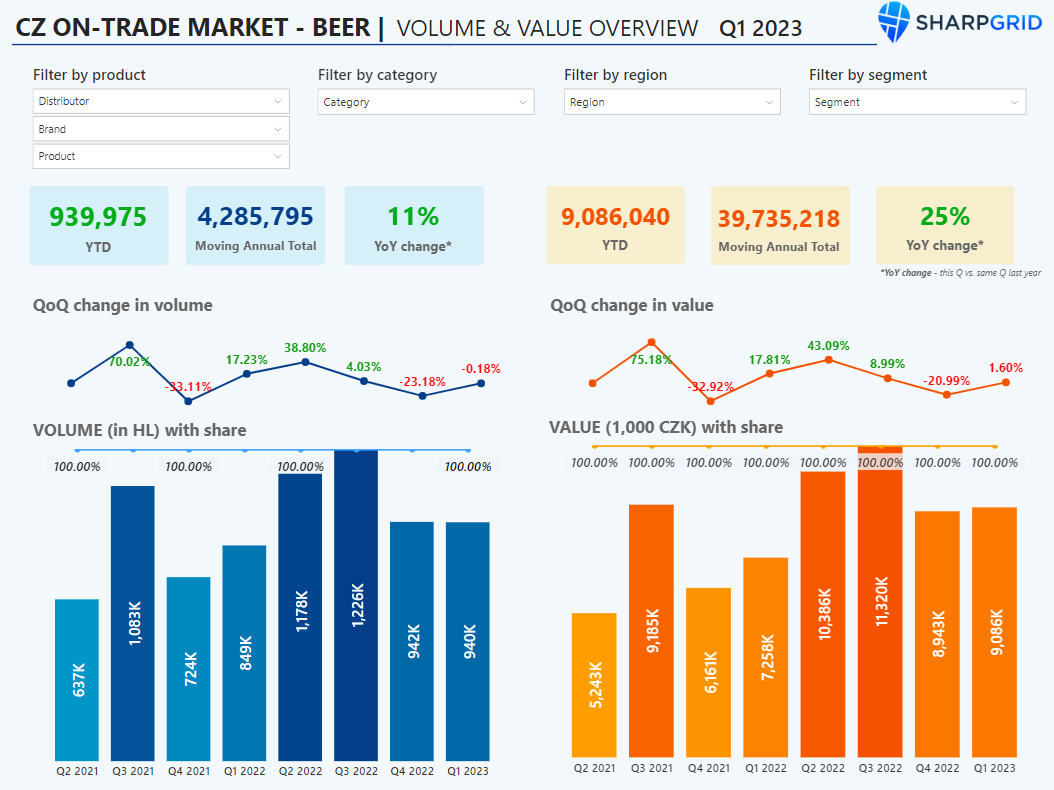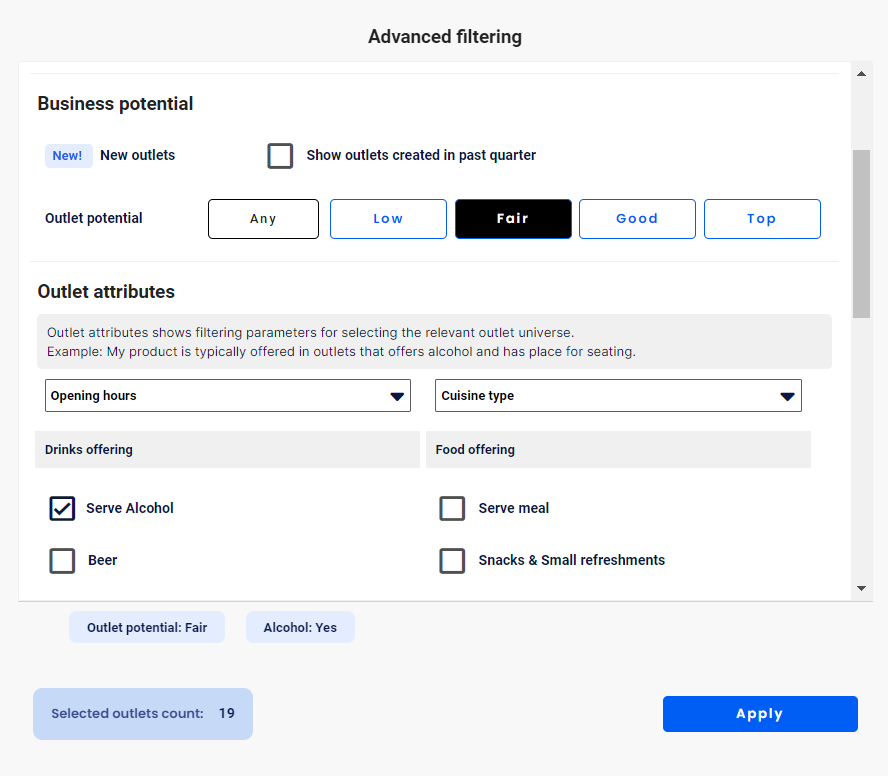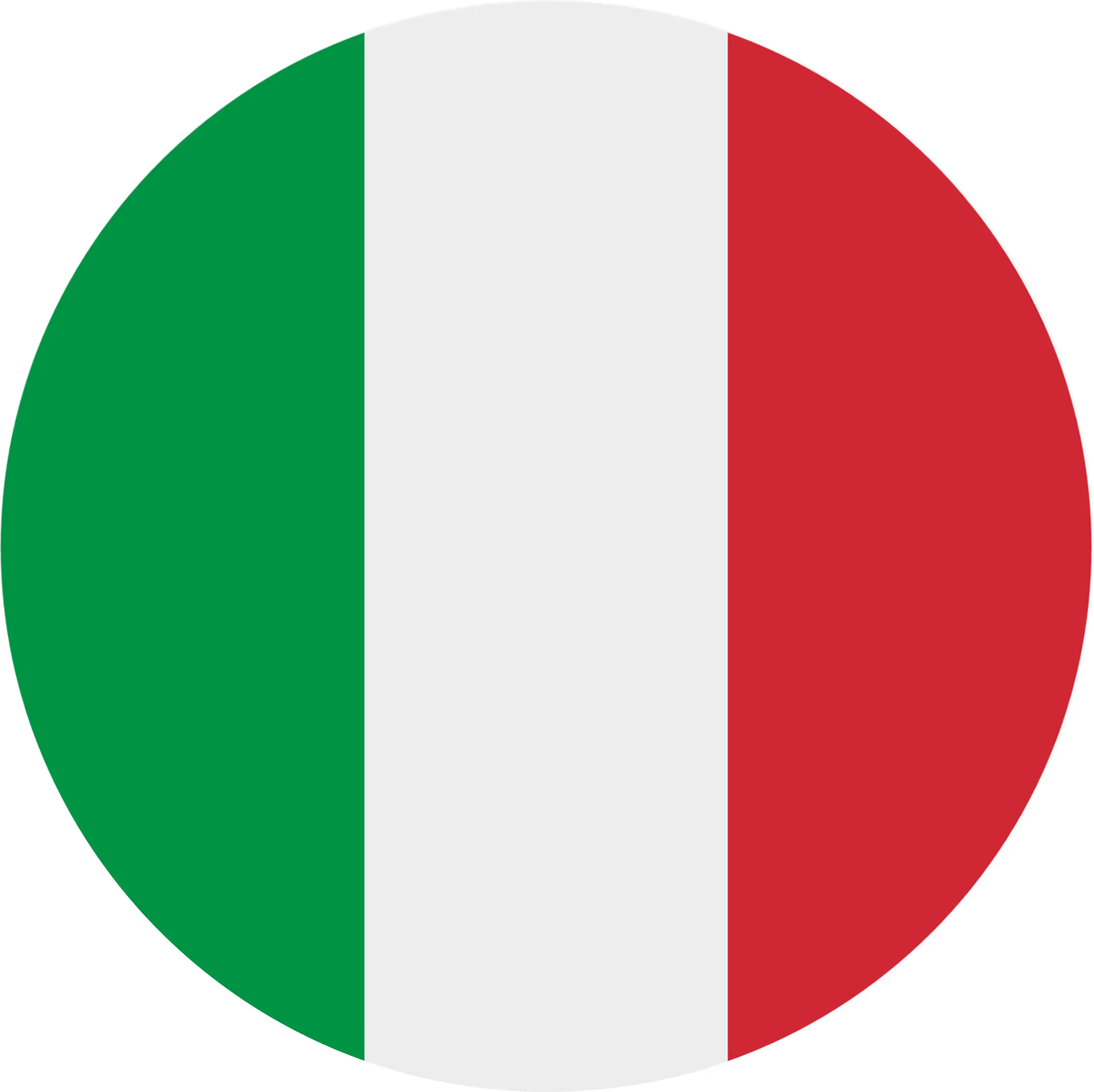Sell more with POS data analysis in the HoReCa sector


In the bustling landscape of the on-trade / HoReCa sector, every point of sale (POS) tells a unique tale - a tale woven with countless threads of data, each holding a nugget of valuable insight. And when you unravel these threads through POS data analysis, you unlock a wealth of knowledge that can transform your business strategy. Remember, in this data-driven era, those who truly understand where they stand are the ones who will shape the future.
But let's take a step back for a moment and consider a common scenario. A customer walks into a restaurant, orders a refreshing beverage, and enjoys their evening. This story may seem simple, but beneath the surface, there's a lot happening. What beverage did they choose? When did they visit? Why did they choose this place specifically? The end of this story, marked by a transaction at the point of sale, is just the beginning for anyone paying attention to the numbers.
POS data analysis is a secret weapon
Whether you're a beverage producer, a vendor, or someone who simply needs to understand the on-trade landscape, POS data analysis is your secret weapon. It can reveal patterns and trends, consumer preferences, sales volumes, and much more. But that's not all. The true power of POS data analysis lies in its ability to offer a deeper, more nuanced understanding of your customers - the restaurants, cafés, bars, and other outlets that are crucial touchpoints for your products.
Picture an interactive map where each dot represents an outlet. Click on a dot, and you uncover a profile detailing everything from their business potential and growth rate to their customer ratings and offerings. Imagine being able to filter this map based on specific criteria, giving you the ability to create targeted "hit lists" for strategic decision making. Or a next-gen interactive report with prices or market shares for you and your competitors. Easy to access in a few clicks. Sounds exciting, right? That's the potential of POS data analysis!

This isn't the future - this is here, and now. Welcome to the compelling world of POS data analysis, a place where data-driven insights meet strategic decision-making to unlock exponential growth in the vibrant HoReCa sector. So, are you ready to dive in?
What exactly is POS data?
In the digital age, data is the new gold. And in the on-trade / HoReCa sector, the Point of Sale (POS) system is one of the most significant mines where this valuable resource is excavated. So, what exactly is POS data?
At its core, POS data represents the details captured during the transaction process when a customer makes a purchase at a restaurant, café, bar, or any other on-trade outlet. It's a digital footprint of a customer's interaction with the establishment, offering a snapshot of their buying behavior. But let's delve deeper.
POS data records the basic transaction information such as the date and time of purchase, the items bought, their quantities, and the total bill amount. Simple enough, right? But the beauty of lies in its depth and the outcomes of a proper POS data analysis.
It can capture the specifics of each product purchased - brand, type, size, flavor. It tells you if the consumer prefers their Red Bull straight up or as a cocktail mixer. It hints at the popularity of Heineken over local brews.

This myriad of information, when collected, organized, and analyzed, paints a detailed picture of the on-trade outlets, the end consumers, and the dynamics between them. POS data analysis, therefore, becomes an essential tool, turning raw numbers into meaningful narratives that can guide informed decision-making.
In essence, POS data isn't just numbers on a screen. It's the heartbeat of the HoReCa sector, a rhythm that, when deciphered, can help businesses adapt, innovate, and thrive. So, let's start listening.
See how various beverage brands are doing in Italy, Spain, Poland, Czechia and Slovakia
The Art and Science of POS Data Analysis
The process of transforming raw POS data into insightful narratives involves both scientific precision and artistic interpretation. This combination is what makes POS data analysis not just a process, but an intriguing journey.
First up, the Science: Collect, Clean, and Classify.
Data collection begins at the point of sale, each transaction adding another piece to the puzzle. Data in its raw form can be messy, inconsistent, and, at times, overwhelming. This is where data cleaning comes in, sifting through the chaos to ensure accuracy and consistency. The next step is classification, where data is organized into meaningful categories, paving the way for easier analysis.
Now, the Art: Analyze, Interpret, and Visualize.
POS data analysis is where the magic happens. With the help of advanced tools and algorithms, patterns start to emerge, trends become visible, and the seemingly random pieces of information begin to form a cohesive story. The interpretation phase adds context to these findings, ensuring the insights align with real-world dynamics and business objectives. The final piece of the puzzle is data visualization, transforming complex datasets into intuitive outlet profiles, graphs and charts, making the insights accessible and understandable.

But POS data analysis is not a one-and-done process. It's an ongoing cycle of learning, adapting, and evolving. Each new piece of data can alter the narrative, bring fresh insights to light, and provide new opportunities for growth and improvement. In SharpGrid, we update our BI tools and databases every quarter and we will be able to do it even more often in the near future.
Understanding the art and science of POS data analysis can be the difference between simply surviving and thriving. It's not just about the numbers, but the stories they tell.
Case Studies: POS Data Analysis in Action
Having unraveled the process and potential of POS data analysis, let's put a real-world lens on it. Here are some transformative examples from industry giants, showcasing how POS data analysis can supercharge operations and accelerate growth.
Case Study 1: Danone Italy and Alpro Milk
For Danone Italy, POS data analysis paved the way to a more streamlined and effective strategy. Looking to bolster the sales of their Alpro milk in specific cafés, Danone turned to the power of our tool Outlet Census Live. Using a targeted approach based on the insights extracted from the data, they were able to identify and focus on the outlets with the highest potential. The result? They saved up to four months of their teams' time, substantially increasing their efficiency and enabling faster results.
Case Study 2: Heineken's Sales Revolution
Heineken offers a prime example of the transformative impact of POS data analysis on sales operations. Traditionally, sales strategies were heavily dependent on the intuitive knowledge of their salespeople, which could often be biased or inaccurate. By integrating POS data analysis into their operations, Heineken shifted their approach. Now, they base their sales strategies on objective, precise data, reducing biases, and enhancing the effectiveness of their decision-making process.
Case Study 3: Unilever's Massive Customer Acquisition
For Unilever, POS data analysis played a pivotal role in a radical shift in their sales model. Leveraging the insights gleaned from POS data, they managed to reimagine their sales approach, focusing on those outlets where they had the best opportunity for success. This data-driven strategy led to an astounding increase in customer acquisition by over 300%, proving the unparalleled potential of POS data analysis in transforming sales strategies.
These case studies illustrate that POS data analysis isn't just theoretical; it's practical, actionable, and a significant game-changer. The insights derived from POS data analysis can fuel strategic decisions, revolutionize operations, and ultimately, drive businesses towards growth and success in the dynamic HoReCa sector.
How Can HoReCa Companies Benefit From POS Data Analysis?
Stepping into the realm of POS data analysis opens a world of advantages. A few common themes stand out.
1. Personalized Marketing
Knowing your customers' preferences, habits, and behaviors can transform your marketing strategy. With POS data analysis, you can fine-tune your marketing campaigns, tailoring them to align with the tastes and demands of the outlets and end consumers. This personalized approach enhances customer engagement, leading to better results from your marketing efforts.
2. Optimized Inventory Management
POS data analysis provides insights into sales trends and patterns. Understanding what sells when and where, you can better manage your inventory. This means fewer stock-outs and overstocks, ensuring that the right products are always available at the right time, enhancing customer satisfaction.
3. Accurate Sales Forecasting
With a clear view of past and current sales trends, you can more accurately predict future sales. This allows for more informed decision-making and planning, leading to increased efficiency and profitability.
4. Identifying Growth Opportunities
By analyzing POS data, you can identify opportunities for growth that might otherwise go unnoticed. Whether it's a rising trend in craft beers or an unmet demand for luxurious whiskey, POS data analysis can help you spot and capitalize on these opportunities.
5. Enhanced Customer Experience
Through POS data analysis, you can understand what your customers want and expect. This enables you to tailor your offerings to meet these expectations, thereby improving the overall customer experience, leading to higher customer retention and loyalty.
In a nutshell, POS data analysis turns data into actionable insights. It's the secret ingredient that can give companies the competitive edge they need.
Challenges of POS Data Analysis and the Way Forward
Fully embracing and effectively utilizing POS data analysis involves overcoming certain challenges and strategic forward-thinking. Moreover, staying attuned to future trends will be crucial for sustained success.
The sheer volume of data to be managed, the need for specific expertise, and the requirement for advanced tools for data organization and interpretation can be challenging. Additionally, ensuring data quality and accuracy is paramount as these factors directly impact the reliability of the insights obtained.
In a world where data protection regulations are tightening, the ethical handling of sensitive information also poses a significant concern. Businesses must ensure their data practices comply with regulations and prioritize data security. Despite these challenges, the transformative potential of POS data analysis remains a game-changer. So, how do businesses navigate this landscape?
Primarily, investing in the right tools and skills is key. In SharpGrid, we specialize in such tools with our flagship product being the Outlet Census Live interactive BI tool for sales, business intelligence or marketing.
Access Outlet Census Live for free today
Utilizing sophisticated data analysis software and nurturing a data-literate team can turbocharge your analysis game and bring instant results to your operating business. Ensuring data quality through reliable collection methods and data cleaning processes is a must. Looking ahead, the significance of POS data analysis in the HoReCa sector is only set to grow. As the industry becomes increasingly competitive, making data-driven decisions will be the cornerstone of any successful strategy. It's about fostering a culture of data literacy where data actively informs business strategies and growth.
The future of the HoReCa sector is intimately tied with POS data analysis. It's not merely a trend but an essential tool for growth. It's the way forward, shaping the path towards innovation, improvement, and sustainable success. We can safely say that the successful businesses of tomorrow will be those that understand, embrace, and optimally leverage POS data analysis.






